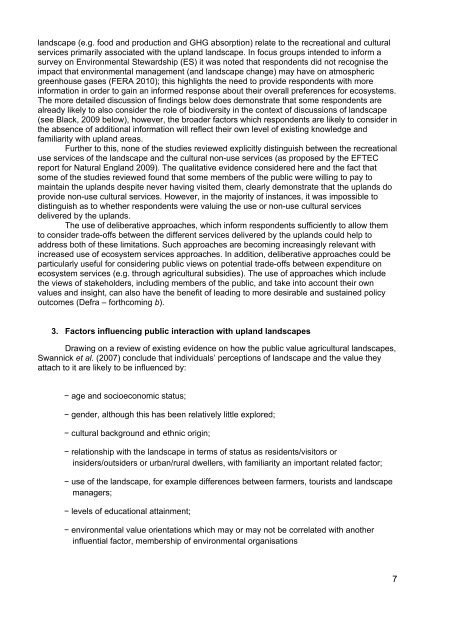Public Attitudes and Preferences for Upland Landscapes - Defra
Public Attitudes and Preferences for Upland Landscapes - Defra
Public Attitudes and Preferences for Upland Landscapes - Defra
You also want an ePaper? Increase the reach of your titles
YUMPU automatically turns print PDFs into web optimized ePapers that Google loves.
l<strong>and</strong>scape (e.g. food <strong>and</strong> production <strong>and</strong> GHG absorption) relate to the recreational <strong>and</strong> cultural<br />
services primarily associated with the upl<strong>and</strong> l<strong>and</strong>scape. In focus groups intended to in<strong>for</strong>m a<br />
survey on Environmental Stewardship (ES) it was noted that respondents did not recognise the<br />
impact that environmental management (<strong>and</strong> l<strong>and</strong>scape change) may have on atmospheric<br />
greenhouse gases (FERA 2010); this highlights the need to provide respondents with more<br />
in<strong>for</strong>mation in order to gain an in<strong>for</strong>med response about their overall preferences <strong>for</strong> ecosystems.<br />
The more detailed discussion of findings below does demonstrate that some respondents are<br />
already likely to also consider the role of biodiversity in the context of discussions of l<strong>and</strong>scape<br />
(see Black, 2009 below), however, the broader factors which respondents are likely to consider in<br />
the absence of additional in<strong>for</strong>mation will reflect their own level of existing knowledge <strong>and</strong><br />
familiarity with upl<strong>and</strong> areas.<br />
Further to this, none of the studies reviewed explicitly distinguish between the recreational<br />
use services of the l<strong>and</strong>scape <strong>and</strong> the cultural non-use services (as proposed by the EFTEC<br />
report <strong>for</strong> Natural Engl<strong>and</strong> 2009). The qualitative evidence considered here <strong>and</strong> the fact that<br />
some of the studies reviewed found that some members of the public were willing to pay to<br />
maintain the upl<strong>and</strong>s despite never having visited them, clearly demonstrate that the upl<strong>and</strong>s do<br />
provide non-use cultural services. However, in the majority of instances, it was impossible to<br />
distinguish as to whether respondents were valuing the use or non-use cultural services<br />
delivered by the upl<strong>and</strong>s.<br />
The use of deliberative approaches, which in<strong>for</strong>m respondents sufficiently to allow them<br />
to consider trade-offs between the different services delivered by the upl<strong>and</strong>s could help to<br />
address both of these limitations. Such approaches are becoming increasingly relevant with<br />
increased use of ecosystem services approaches. In addition, deliberative approaches could be<br />
particularly useful <strong>for</strong> considering public views on potential trade-offs between expenditure on<br />
ecosystem services (e.g. through agricultural subsidies). The use of approaches which include<br />
the views of stakeholders, including members of the public, <strong>and</strong> take into account their own<br />
values <strong>and</strong> insight, can also have the benefit of leading to more desirable <strong>and</strong> sustained policy<br />
outcomes (<strong>Defra</strong> – <strong>for</strong>thcoming b).<br />
3. Factors influencing public interaction with upl<strong>and</strong> l<strong>and</strong>scapes<br />
Drawing on a review of existing evidence on how the public value agricultural l<strong>and</strong>scapes,<br />
Swannick et al. (2007) conclude that individuals’ perceptions of l<strong>and</strong>scape <strong>and</strong> the value they<br />
attach to it are likely to be influenced by:<br />
− age <strong>and</strong> socioeconomic status;<br />
− gender, although this has been relatively little explored;<br />
− cultural background <strong>and</strong> ethnic origin;<br />
− relationship with the l<strong>and</strong>scape in terms of status as residents/visitors or<br />
insiders/outsiders or urban/rural dwellers, with familiarity an important related factor;<br />
− use of the l<strong>and</strong>scape, <strong>for</strong> example differences between farmers, tourists <strong>and</strong> l<strong>and</strong>scape<br />
managers;<br />
− levels of educational attainment;<br />
− environmental value orientations which may or may not be correlated with another<br />
influential factor, membership of environmental organisations<br />
7
















